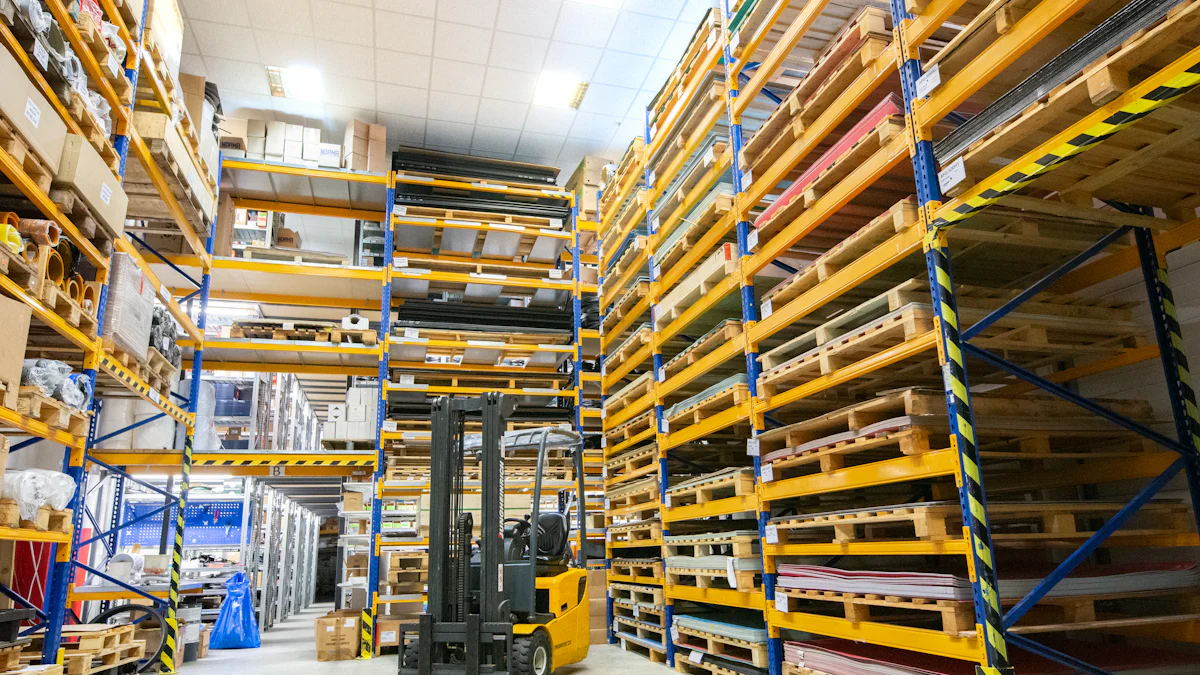logistics warehousing

Logistics warehousing involves the storage and management of goods within a warehouse. This process plays a critical role in supply chain management by ensuring efficient inventory control and timely distribution. Effective logistics warehousing enhances operational efficiency, reduces costs, and improves customer satisfaction.
Foundational Concepts
Definition and Scope
What is logistics warehousing?
Logistics warehousing refers to the systematic process of storing and managing goods within a warehouse. This involves the physical flow of products during receiving and shipping, along with the associated data like fulfillment details. Warehouses serve as essential hubs in the supply chain, providing storage facilities for upstream and downstream operations.
Key components of logistics warehousing
Key components of logistics warehousing include:
Inventory Management: Ensuring product availability and minimizing risks.
Storage Solutions: Utilizing space efficiently to store various types of goods.
Technology Integration: Implementing advanced systems for tracking and managing inventory.
Workforce Management: Training staff to handle warehousing tasks effectively.
Safety Protocols: Maintaining health and safety standards to protect goods and staff.
Importance in Supply Chain
Role in inventory management
Logistics warehousing plays a crucial role in inventory management. Effective warehouse management enables companies to store and handle a wide range of products across the entire system. Proper inventory control ensures that products are available when needed, reducing the risk of stockouts and overstock situations.
Impact on delivery times and customer satisfaction
Warehousing directly impacts delivery times and customer satisfaction. Efficient logistics warehousing supports the customer service process by ensuring the delivery of quality products in terms of quantity, quality, and delivery status. Timely and specified deliveries contribute to better customer experiences, enhancing overall satisfaction.
Setting Up a Warehouse

Site Selection
Factors to consider
Selecting an optimal warehouse location involves evaluating multiple criteria. Key factors include:
Land Cost: Assessing the affordability of land in potential locations.
Infrastructure Access: Ensuring proximity to major highways, ports, and railways for efficient transportation.
Workforce Availability: Considering the local labor market to ensure a steady supply of skilled workers.
Delivery Time: Evaluating how the location impacts delivery times to customers.
Area Competitiveness: Analyzing the presence of competitors and market demand in the area.
Location Capacity: Ensuring the site can accommodate future expansion needs.
Transportation Modes: Availability of various transportation options like road, rail, air, and sea.
A study on warehouse location selection in Belgrade highlighted these criteria as essential for determining the optimal site.
Strategic location benefits
Strategically located warehouses offer numerous benefits:
Reduced Transportation Costs: Proximity to major transport hubs minimizes shipping expenses.
Improved Delivery Times: Faster access to key markets enhances customer satisfaction.
Operational Efficiency: Centralized locations streamline distribution processes.
Market Reach: Expanding reach to new markets boosts business growth.
Scalability: Locations with ample space support future expansion plans.
Warehouse Design
Layout planning
Effective warehouse design starts with meticulous layout planning. Key considerations include:
Space Utilization: Maximizing storage capacity while ensuring easy access to goods.
Workflow Optimization: Designing pathways to minimize travel time and enhance productivity.
Zoning: Creating designated areas for different activities like receiving, storage, picking, and shipping.
Safety Measures: Implementing safety protocols to protect workers and goods.
Proper layout planning ensures smooth operations and maximizes efficiency.
Equipment and technology
Modern warehouses leverage advanced equipment and technology to enhance operations. Essential components include:
Automated Storage and Retrieval Systems (AS/RS): These systems automate the storage and retrieval of goods, reducing labor costs and increasing accuracy.
Warehouse Management Systems (WMS): Software solutions that track inventory levels, manage orders, and optimize storage locations.
Material Handling Equipment: Forklifts, conveyors, and pallet jacks facilitate the movement of goods within the warehouse.
Robotics: Mobile robots assist in picking and packing tasks, boosting productivity and accuracy.
IoT Devices: Sensors and connected devices monitor environmental conditions and track assets in real-time.
Integrating these technologies enhances operational efficiency and reduces errors.
Operational Considerations
Inventory Management
Stock control methods
Effective stock control methods ensure optimal inventory levels. Companies use various techniques to manage inventory efficiently:
Just-In-Time (JIT): Minimizes stock levels by receiving goods only when needed for production or sales.
Economic Order Quantity (EOQ): Determines the ideal order quantity to minimize total inventory costs, including holding and ordering expenses.
ABC Analysis: Categorizes inventory into three classes (A, B, C) based on importance and value, allowing focused management of high-priority items.
First-In-First-Out (FIFO): Ensures older stock gets sold first, reducing the risk of obsolescence.
Safety Stock: Maintains a buffer of extra inventory to prevent stockouts during demand fluctuations.
These methods help businesses maintain balanced inventory levels, reduce carrying costs, and improve cash flow.
Technology in inventory management
Technology plays a crucial role in modern inventory management. Advanced systems provide real-time insights and streamline operations:
Warehouse Management Systems (WMS): Track inventory levels, manage orders, and optimize storage locations. These systems integrate seamlessly with other devices and platforms.
Radio Frequency Identification (RFID): Enhances inventory visibility and accuracy by using RFID scanners for advanced picking and tracking.
Barcodes and Barcode Scanners: Aggregate information about products and their locations, organizing and tracking inventory across multiple warehouses.
Inventory Management Software: Provides real-time updates on stock levels and replenishment needs, revealing information about products, sizes, colors, and quantities on hand.
Automated Picking Technologies: Include paperless automated picking and pick-to-light systems, improving efficiency and reducing errors.
Implementing these technologies boosts operational efficiency, reduces manual labor, and enhances inventory accuracy.
Workforce Management
Training and development
Proper training and development are essential for an efficient warehouse workforce. Key aspects include:
Onboarding Programs: Introduce new employees to warehouse operations, safety protocols, and company policies.
Skill Development: Provide ongoing training to enhance employees' skills in areas like equipment handling, inventory management, and technology use.
Cross-Training: Train employees in multiple roles to increase flexibility and coverage during peak times or staff shortages.
Performance Monitoring: Regularly assess employee performance and provide feedback to encourage continuous improvement.
Leadership Training: Develop future leaders through specialized programs that focus on management skills and team coordination.
Investing in workforce training ensures a skilled, adaptable, and motivated team, leading to improved productivity and job satisfaction.
Safety protocols
Maintaining safety protocols is vital for protecting workers and goods in a warehouse environment. Key measures include:
Personal Protective Equipment (PPE): Ensure all employees wear appropriate PPE, such as gloves, helmets, and safety shoes.
Safety Training: Conduct regular training sessions on safe equipment use, emergency procedures, and hazard recognition.
Ergonomic Practices: Implement ergonomic practices to reduce the risk of injuries from repetitive tasks or heavy lifting.
Regular Inspections: Perform routine inspections of equipment and facilities to identify and address potential safety hazards.
Clear Signage: Use clear signage to indicate hazardous areas, emergency exits, and safety procedures.
Adhering to these safety protocols minimizes the risk of accidents, ensures compliance with regulations, and fosters a safe working environment.
Challenges and Solutions

Common Challenges
Space Utilization
Space utilization poses a significant challenge in warehouse management. Inefficient use of space can lead to cluttered aisles and difficulty in locating products. A poorly configured warehouse often results in underutilized capacity. The average warehouse capacity utilization stands at only 68%. This statistic highlights the inefficiency in space management. Inaccurate inventory management exacerbates this issue. Workers may go to a location where the product is unavailable, causing delays and errors.
Managing Peak Seasons
Managing peak seasons presents another major challenge. During high-demand periods, warehouses face increased pressure to fulfill orders promptly. Orders can come from various sources such as company websites, e-commerce portals, and offline sales channels. Traditional methods like Excel sheets and pen-and-paper can lead to errors in order management and fulfillment. The surge in demand during peak seasons often strains resources, leading to delays and customer dissatisfaction.
Effective Solutions
Automation and Technology
Automation and technology offer effective solutions to these challenges. Incorporating automated warehouse management systems (WMS) can significantly improve operations. These systems provide robust inventory management and optimization modules. Automated storage and retrieval systems (AS/RS) reduce labor costs and increase accuracy. Radio Frequency Identification (RFID) enhances inventory visibility and accuracy. Mobile robots assist in picking and packing tasks, boosting productivity. IoT devices monitor environmental conditions and track assets in real-time.
"Incorporating Hopstack's automated warehouse management system can help automate activities and alleviate errors."
Flexible Staffing Strategies
Flexible staffing strategies also play a crucial role in addressing warehouse challenges. Cross-training employees in multiple roles increases flexibility. This approach ensures coverage during peak times or staff shortages. Temporary staffing solutions can help manage increased workloads during high-demand periods. Regular performance monitoring and feedback encourage continuous improvement. Investing in workforce training ensures a skilled, adaptable, and motivated team.
Implementing these solutions enhances operational efficiency and reduces errors, leading to improved customer satisfaction and overall warehouse performance.
Case Studies
Successful Implementations
Company A's approach
Company A optimized warehouse operations by integrating advanced technology. Automated Storage and Retrieval Systems (AS/RS) reduced labor costs and increased accuracy. Warehouse Management Systems (WMS) tracked inventory levels and managed orders efficiently. Mobile robots assisted in picking and packing tasks, boosting productivity. Radio Frequency Identification (RFID) enhanced inventory visibility and accuracy.
Company A also focused on workforce training. Onboarding programs introduced new employees to warehouse operations. Skill development sessions improved equipment handling and inventory management. Cross-training employees in multiple roles increased flexibility during peak times. Regular performance monitoring encouraged continuous improvement.
Company B's strategy
Company B implemented a flexible staffing strategy to manage peak seasons. Temporary staffing solutions addressed increased workloads during high-demand periods. Cross-training employees ensured coverage during staff shortages. Leadership training developed future leaders with strong management skills.
Company B also utilized space efficiently. Layout planning maximized storage capacity while ensuring easy access to goods. Zoning created designated areas for receiving, storage, picking, and shipping. Safety measures protected workers and goods, maintaining a safe working environment.
Lessons Learned
Key takeaways
Advanced technology enhances operational efficiency.
Workforce training improves productivity and job satisfaction.
Flexible staffing strategies address peak season challenges.
Efficient space utilization maximizes storage capacity.
Safety measures protect workers and goods.
Best practices
Implement Automated Storage and Retrieval Systems (AS/RS).
Utilize Warehouse Management Systems (WMS) for inventory tracking.
Train employees in multiple roles for increased flexibility.
Plan warehouse layout to maximize space and optimize workflow.
Maintain safety protocols to ensure a safe working environment.
"Incorporating these best practices can significantly improve warehouse performance and customer satisfaction."
Promotional Content
Company Expertise
Services offered
JUSDA offers a comprehensive suite of logistics and warehousing services designed to meet diverse business needs. Key services include:
Cloud Warehouse Services: Integration with multi-channel sales, automated warehousing, and intelligent transfer through a big data platform. Unified management of Vendor Managed Inventory (VMI) and Customer Managed Inventory (CMI). Personalized VMI edge-of-production-line services and seamless integration with clients' systems.
Integrated Logistics: Customized storage and distribution solutions, particularly for home appliance assembly and delivery. A self-developed e-commerce storage and distribution system that processes numerous orders daily. Meticulous material management and integration with mainstream international and domestic e-commerce platforms' EDI systems.
Cross-Border Services: Comprehensive cross-border trade services, including professional direct express lines, first-mile logistics, and overseas warehousing and distribution. Services cater to merchants, manufacturers, and various consumer endpoints, facilitating seamless cross-border trade with quick and reliable delivery services.
Global Network and Coverage: A global network with over 2.5 million square meters of warehouse space and more than 2,000 international sea, air, and land service routes. 155 service points worldwide and 110 overseas cross-border transfer operation centers ensure extensive coverage and efficient logistics operations.
Specialized Services: Overseas warehouses strategically located for efficient operations. Locations include the East Coast warehouse in Bohemia, the West Coast warehouse in Rancho Cucamonga, and the Central US warehouse in Houston. Professional and cost-effective delivery solutions, especially for new energy DG products and standard parts.
Technological Integration: The JusLink intelligent system platform supports supply chain management and operational services. Integration of suppliers, manufacturers, service providers, and customers for collaborative cooperation. Precise business decision analysis and efficient resource utilization through big data analysis, cloud platform construction, and IoT information system integration.
Client testimonials
Cannon Hill: "We have been customers of Cannon Hill for two years. They handle all our warehousing and shipping logistics for our busy event company and have been very accommodating to our special event needs. They also provide time-sensitive kitting and mailing services, getting our materials across the country in a timely fashion!"
Cannon Hill: "Cannon Hill Logistics has made every element of the distribution process easy and achievable. As a new business owner, I had a lot to learn about logistics and shipping, and Cannon Hill was there for me every step of the way. I know shipping with them will be efficient, cost-effective, and safe. They are professional and a pleasure to work with."
Call to Action
Booking assessments
JUSDA offers personalized assessments to help businesses optimize their logistics and warehousing operations. Schedule an assessment to receive tailored recommendations and strategies for improving efficiency and reducing costs.
Contact information
For more information or to book an assessment, contact JUSDA:
Phone: [Insert Phone Number]
Email: [Insert Email Address]
Website: [Insert Website URL]
Reach out today to discover how JUSDA's expertise can transform your logistics and warehousing operations.
Recap of Key Points: Logistics warehousing involves efficient inventory management, strategic site selection, and advanced technology integration. Proper workforce training and safety protocols ensure smooth operations. Automation and flexible staffing strategies address common challenges like space utilization and peak season management.
Final Thoughts on the Importance of Logistics Warehousing: Warehousing serves as a crucial link in the supply chain network. It enhances overall performance by improving efficiency, mitigating risks, and elevating customer satisfaction. Strategic warehouse placement optimizes shipping times and meets customer expectations.
Encouragement to Take Action or Seek Professional Advice: Businesses should consider optimizing their logistics warehousing operations. Seeking professional advice can provide tailored strategies for improving efficiency and reducing costs. Reach out to experts to transform logistics and warehousing operations.
See Also
Maximizing Warehouse Efficiency with Robotics in Logistics
Unveiling Robotic Automation for Enhanced Warehouse Efficiency
Achieving Success in High-Tech Manufacturing through Lean Logistics
Revealing JUSDA's Logistics Solutions for High-Tech Manufacturing
